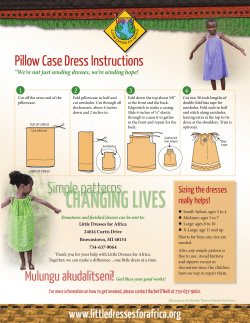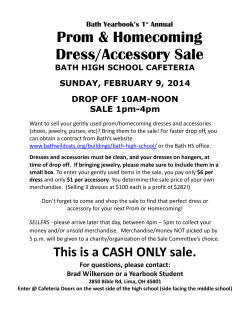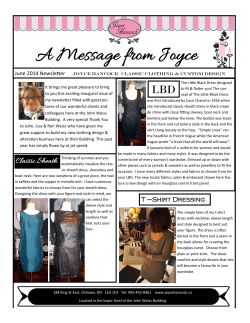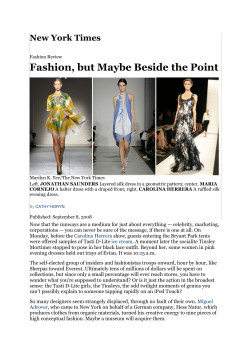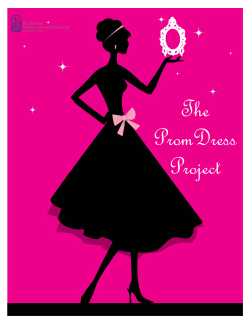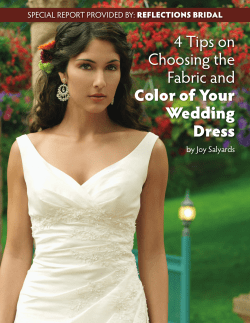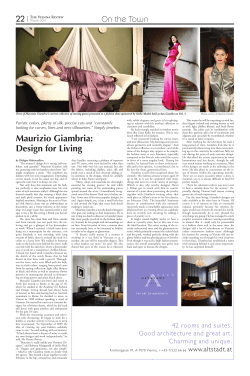
After Dark… Evening Dresses of the Model A Era
After Dark… Evening Dresses of the Model A Era By Lynette Marcione Evening, a time when going out to the theatre, opera, or out to dinner meant dressing in your finest. Most often the styles of women’s evening wear replicated the design attributes of daytime attire, however; with the use of finer fabrics and enhanced trimmings. Paris fashions were copied by New York fashion houses, and translated into evening wear available to everyone by means of retail store locations and catalog stores. Beaded dresses are often associated with the Model A era. The beaded gown reached the height of popularity prior to 1928 but was seen during the era. The hemlines of long beaded gowns popular in the earlier twenties were taken up to accommodate the new shorter hemline, thereby extending the life of these beautiful creations. Catalogs and magazines continued to show beaded dresses available in knee length at a fraction of the cost of designer fashions. Patterns and beaded fabrics by the yard were available for the home seamstress to create their own unique beaded evening gown. After Dark.doc Page 1 April 2007 The most popular look of distinctive evening wear in 1928 was a layered fabric treatment. Dresses were flounced, tiered, cascaded, and draped. The moulded hipline or girdle effect was apparent in most evening dresses as the straight silhouette had not completely vanished but was being modified by a fuller form springing from the hipline with flares, tiers, pleating, inserts, ruffles, or puffed effects. Often the hemlines of this period were varied. Hems were shorter in front and longer in back, uneven or forming a handkerchief effect. Drapes on the side of the hemline often extended beyond the main hemline of the dress. An apron effect was also used on the skirt portion of the dress. Bustles of fabric could be seen as treatments at the back of the dress. Most often the dresses were sleeveless. Popular fabrics were velvets, chiffons, tulle, lame, and satin. Adornments of rhinestones, bows, fabric flowers, attached scarves, side ties, and capes added a touch of femininity to the overall appearance. The Art Deco movement continued to have an influence on the overall styling of the evening dress. Geometric and asymmetrical patterns and designs in contrasting fabrics were used to create a dramatic appearance. After Dark.doc Page 2 April 2007 1929 is often referred to as a year of transition in fashions. The boyish look in the earlier part of the decade was giving way to a return to a more feminine and sophisticated look. Women’s personal attributes of the bust line, waistline, and hipline were being spotlighted. Advertisers were touting white satin gowns with deep décolletage in both the front and back showing far more skin than ever before. More emphasis was being placed on the natural waistline with gatherings near the waist accented with a flower or bow. Many evening gowns were seen with hemlines at ankle length. Although, the uneven hemline was still very popular having a knee length hemline in front with long and irregular points almost touching the floor in back. Dresses of georgette covered with rhinestone and beads were still popular. Tiers, ruffles, and flounces continued to be fashionable accents to the evening gown creating what was referred to by designers as a “fluttering” line. Lace was a well-liked fabric choice for evening wear, in addition to taffeta, chiffons, crepes, and metallics. After Dark.doc Page 3 April 2007 In 1930 evening dress designs took a definite turn toward returning the waistline to the natural line, often accented with small belts or ties. Most dresses were floor length. The overall lines of the dress were slightly flared or fuller, sometimes with fabric insets in the skirt portion. Styles seem to reflect a more refined look, with less fussiness. Necklines were rounded, V-neck, or even a chemise style with tiny straps. The bolero jacket made an attractive accompaniment to the dress, or even an attached belted overcoat complimenting the dress with similar fabrics and colors. Sleeves were caplet style, short, or even long. After Dark.doc Page 4 April 2007 1931 reflected a definite return to the natural waistline; the emphasis was on the graceful curves of the woman. Printed fabrics were in vogue. The “princess” silhouette was a popular style. Deep back treatments forming a V or rounded line were accented with bows, flounces, or fur. Shirring down the front of the dress was a popular accent. Dresses were seen with draping, ruffles, or cascading fabric at the deep necklines. The empire line returned to popularity late in 1931, combining the trendy princess look of the graceful skirt design to the uplifted line of the bodice. Empress Eugenie created fashion frenzy with women copying her personal style in clothing and accessories. The dress style was unique in it’s off the shoulder neckline and crinoline stiffened skirt that billowed in flared tiers with lace edging, a real departure from the general styles of 1931. ####### After Dark.doc Page 5 April 2007
© Copyright 2025
